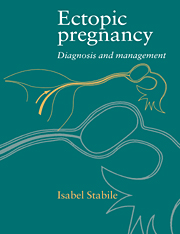Book contents
- Frontmatter
- Contents
- 1 Incidence, aetiology and pathophysiology of ectopic pregnancy
- 2 Clinical presentation of ectopic pregnancy
- 3 Biochemical diagnosis of ectopic pregnancy
- 4 Ultrasound diagnosis of ectopic pregnancy
- 5 Surgical diagnosis
- 6 Practical management of suspected ectopic pregnancy
- 7 Extratubal and unusual ectopic pregnancies
- 8 Medical treatment of ectopic pregnancy
- 9 Conservative and expectant management of ectopic pregnancy
- 10 Radical surgery
- 11 Pregnancy after ectopic pregnancy
- Epilogue: the future
- Index
7 - Extratubal and unusual ectopic pregnancies
Published online by Cambridge University Press: 26 March 2010
- Frontmatter
- Contents
- 1 Incidence, aetiology and pathophysiology of ectopic pregnancy
- 2 Clinical presentation of ectopic pregnancy
- 3 Biochemical diagnosis of ectopic pregnancy
- 4 Ultrasound diagnosis of ectopic pregnancy
- 5 Surgical diagnosis
- 6 Practical management of suspected ectopic pregnancy
- 7 Extratubal and unusual ectopic pregnancies
- 8 Medical treatment of ectopic pregnancy
- 9 Conservative and expectant management of ectopic pregnancy
- 10 Radical surgery
- 11 Pregnancy after ectopic pregnancy
- Epilogue: the future
- Index
Summary
Introduction
Approximately 3–5% of all ectopic pregnancies are extratubal. They account for one-fifth of all maternal deaths from ectopic pregnancy. Extratubal implantation occurs most commonly in the ovary, cervix and abdominal cavity. Very rarely the fertilized ovum implants in a rudimentary uterine horn or on the broad ligament. The incidence, clinical features and diagnosis of each of these forms of ectopic pregnancy are described in this chapter.
Ovarian pregnancy
One to three percent of all ectopic pregnancies are located in the ovary. Ovarian pregnancy occurs when the ovum is fertilised and implants within its follicle (primary) or from implantation of an early tubal abortion on the surface of the ovary (secondary). It occurs in approximately one in 7000 deliveries. Twin ovarian pregnancy has been reported (Ohba et al., 1992). The criteria for surgical diagnosis of ovarian pregnancy are an intact tube on the affected side with the gestation sac located at the ovarian site and connected to the uterus by the utero-ovarian ligament (Box 7.1). In addition, histological evidence of ovarian tissue in the wall of the sac should be obtained (Spiegelberg, 1878). Lehfeldt et al. (1970) have shown that users of the intrauterine contraceptive device (IUD) have a higher ratio of ovarian to total ectopic pregnancies (1:9) than non-users. The IUD prevents intrauterine implantation in 99.5% of cases, tubal implantation in 95% of cases and ovarian implantation not at all.
- Type
- Chapter
- Information
- Ectopic PregnancyDiagnosis and Management, pp. 80 - 94Publisher: Cambridge University PressPrint publication year: 1996



